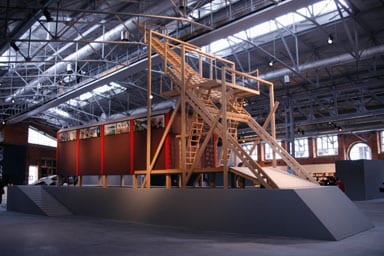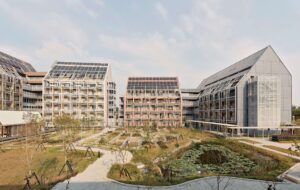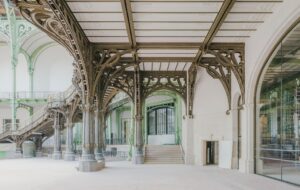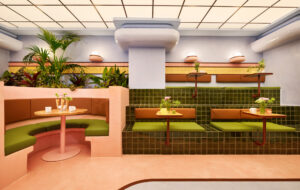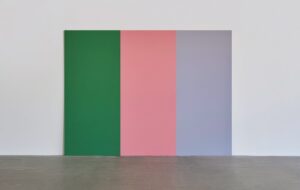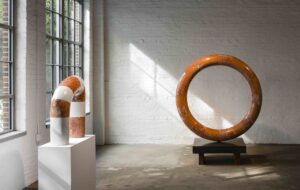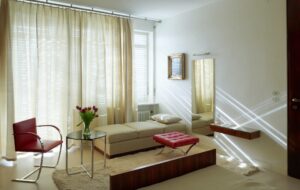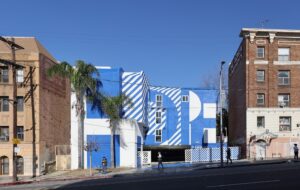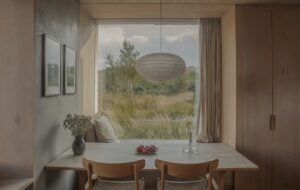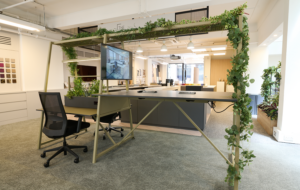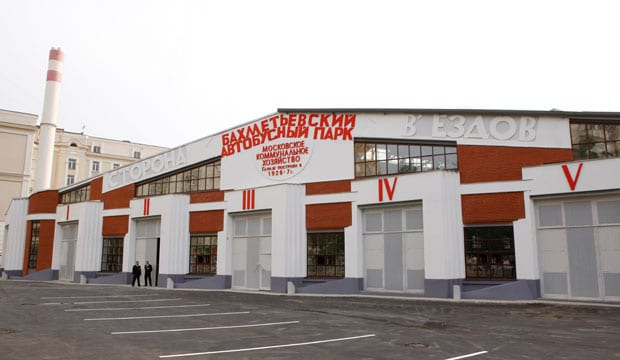
words Beatrice Galilee
Konstantin Melnikov’s constructivist bus garage in Moscow has been turned ito an enormous cultural venue, a rare victory against the all-powerful developers. Beatrice Galilee paid it a visit.
Cultural buildings in Russia tend to be bombastic affairs: majestic, beautiful and intense with gold furnishings and intimidating grand spaces. So the taxi driver was unsure why I started tapping on my window when we drove past a large white bus garage in a suburban Jewish neighbourhood north-east of Moscow’s city centre. To him, this was just another relic of the city’s distant Soviet past.
But the model of industrial gentrification that started in Berlin, London and New York in the 1970s and 80s has reached Russia. The old factories and warehouses of Soviet times are now host to parasitical art galleries, dance groups and workshops. And this large white building is the Bakhmetevsky Bus Garage, a spectacular avant garde building designed by Konstantin Melnikov in 1927, now the largest art exhibition space in the city.
The Garazh, or GCCC Moscow, is a hugely ambitious project spearheaded by Roman Abramovic’s girlfriend, Dasha Zhukova. It covers almost the same area as the ground floor of Tate Modern – to the metre. There is no collection to fill this giant space, which will instead hold a library, an education centre and a cinema, all designed by London-based architect Jamie Fobert and coming over the next year. Moscow, unlike Paris and London doesn’t attract cultural tourists and so this building must serve the Russian art scene well. But one thing is clear, there will be no glass boxes glowing at night here. There is a distinct feeling that for all its similarities, this is not like Tate Modern.
It is no coincidence that the debut exhibition for this art gallery is by Russian conceptual artists Ilya and Emilia Kabakov. The Moscow-born and New-York based pair haven’t put a show on in Russia for 20 years, but they had a huge sympathy for this architect and this building. Melnikov intended the structure to be a symbol of individualism in a sea of Soviet conformity and a promise of a solid, radical Russian identity. But money ran out and the buses this garage was supposed to house never ran. The Kabakovs campaigned for the emasculated building to be restored, publishing their own proposals for the space (icon 060), and are now on the GCCC board.
In this show, however, the Kabakovs rarely engage the building in any explicit way. Their installation, The Alternative History of Modern Art, is in a self-contained structure. It’s an imaginary art gallery with 23 rooms, showing three exhibitions by three imaginary artists, each of whom has a confused attitude to the past and is preoccupied with ideas of artistic identity. There is deliberately no sense of place other than the temporary beige walls and low ceilings that the Kabakovs have installed. The artists relish satirising nostalgia for the “good old days” but this work has been touring and is not bespoke to this ripe context.
Their other installation, the Red Wagon, is a more sculptural work with a specific relationship to the industrial architecture around it. Inside, a “museum of Soviet culture” plays a celebratory soundtrack behind a mural of balloons flying over a prosperous city. A vaguely Tatlin-esque ladder is propped against the front of the wagon, soaring into pretty much nothing, and at the rear there is a crumpled heap of rubbish. The elaborate, inaccessible and pointless ladder is a neat metaphor for the failed utopia that gave rise to this building.
The curators and owners of the Garazh hope it will kick-start a new way of dealing with industrial spaces in the city. But Moscow has sold itself to the developers, and the city may have to fight hard to hang onto this new wave.
